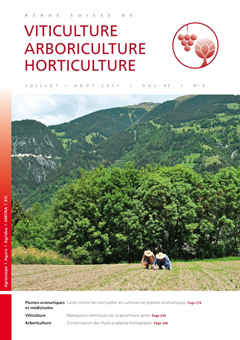
Issue 4 - July - August 2011
Abstract in open access
The Swiss producers of aromatic plants had to face a massive attack of caterpillars in their crops in 2009. It was caused by a migratory butterfly of the moths family, Heliothis peltigera. This invasion is not expected every year. Regular crop monitoring since the start of May allows to distinguish between a virulent attack of this pest from a local attack of a domestic butterfly. The control method suggested by ACW consists in monitoring one hundred plants once a week as from mid-May (one leaf per plant), then twice a week since the beginning of June. The damage threshold is currently set at 5 % (five plants attacked out of hundred). Above this value, a treatment with the active ingredient spinosad is recommended in aromatic plants organic production.
Keywords: Heliothis peltigera, biology, efficacy trial, spinosad
E-Mail: catherine.baroffio@acw.admin.ch
Adress:
Abstract in open access
The American grape leafminer Phyllocnistis vitegenella Clemens (Lepidoptera: Gracillariidae) is a pest with origin in North America. In Italy its occurrence was reported in 1995. In Southern Switzerland, where the insect completes three generations annually, it has been observed for the first time in 2009. Currently the region around Lugano represents its northern limit of spread. The percentage of damaged leaves per plant increases during August and September. A level of leaf damage of 30.5 % was determined during the grape picking period. Evaluations carried out during the second and at the end of the third generation revealed frequencies of parasitism of 13 and 16.7 % respectively were observed. This indicates a quick response of the environment to this new exotic pest. Seven species of microhymenoptera were determined, belonging to Eulophidae family. The observed parasitism is mainly attributed to three species: Chrysocharis nephereus, Minotetrastichus ecus and Closterocerus trifasciatus.
Keywords: population dynamic, leaf damage, microhymenoptera, Eulophidae
E-Mail: mauro.jermini@acw.admin.ch
Adress:
Abstract in open access
The research station Agroscope Changins-Wädenswil ACW performed a series of studies to identify more precisely the chemical compounds involved in an infection caused by Botrytis cinerea. These compounds were correlated to generic indexes given by indirect spectrometers (like Winescan®). In vitro studies using twelve grape varieties representative of Swiss vineyards led to the determination of major chemical changes in the composition of the berries. Galacturonic and mucic acids were identified as new markers of Botrytis. Field studies along the ripening period on selected varieties of grapes both sensitive and resistant confirmed the relevance of these markers and their contribution in the measurement of global sanitary indexes. These parameters will further enable the optimization of generic models in order to reflect relevant sanitary information for practical use.
Keywords: sanitary indexes, Botrytis cinerea, grey mould, galacturonic acid, mucic acid
E-Mail: agnes.dienes-nagy@acw.admin.ch
Adress:
Abstract in open access
Following positive trials in laboratory, six strains of biological control agents on pome fruits were evaluated in reducing post-harvest disease. These strains were tested in biological orchard on two apple and one pear varieties. Our experiment showed the variability of the results obtained in open field. The diversity of moulds at the exit of cold storage treatment is greatly influenced by the strains used during the application. A careful harvest of fruits stills the best practice to promote for a good quality at the end of the storage system.
Keywords: pome fruits, storage diseases, open field experiments, biological control agents
E-Mail: dominique.fleury@eichangins.ch
Adress:
Abstract in open access
The experiment carried out between 2005 and 2010 in 24 plots of Vitis vinifera cv. Cornalin in the Valais region, enabled to show the high impact of water restriction and magnesium deficiency on the physiology of cv. Cornalin. Regions with stronger water restriction had lower vigour. In moderate water constraint, appeared a plateau with optimum residual sugar and total acidity levels in terms of must quality. Ten plots were under Mg deficiency. The intensity of Mg deficiency was growing from up- to downstream parts of the Valais region. Highest Mg deficiencies were observed in plots under lower water restriction. A relation between rachis necrosis and Mg level in leaves was established. Mg level was a good indicator of grape quality: total acidity was higher (+1 g/l as tartaric acid) and residual sugar content lower (-1 °Brix) when Mg deficiency symptoms on leaves were the highest (> 75 % of the canopy), in comparison to a situation without Mg deficiency.
Keywords: Cornalin, water restriction, magnesium deficiency, grapevine physiology
E-Mail: vivian.zufferey@acw.admin.ch
Adress:

 Download of full issue
Download of full issue
 Download article
Download article